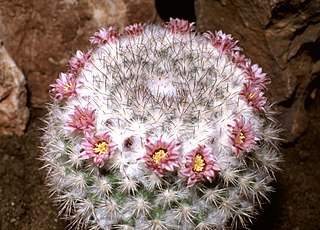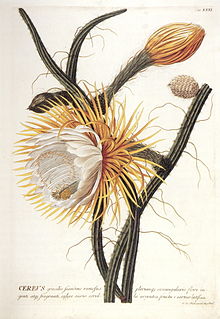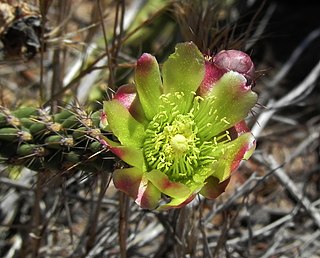
Mammillaria is one of the largest genera in the cactus family (Cactaceae), with currently 200 known species and varieties recognized. Most of the mammillaria are native to Mexico, but some come from the southwest United States, the Caribbean, Colombia, Venezuela, Guatemala and Honduras. The common name "pincushion cactus" refers to this and the closely related genus Escobaria.

Bergerocactus emoryi is a species of cactus, known commonly as the golden-spined cereus, golden snake cactus, velvet cactus or golden club cactus. It is a relatively small cactus, but it can form dense thickets or colonies, with the dense yellow spines giving off a velvety appearance when backlit by the sun. From April to May, yellow, green-tinged flowers emerge, which transform into reddish, globular fruit. This species is native to the California Floristic Province, and is found in northwestern Baja California and a small part of California, in San Diego County and on the southern Channel Islands. Where the Mediterranean climate of the California Floristic Province collides with the subtropical Sonoran Desert near El Rosario, hybrids with two other species of cacti are found. It is the sole member of the monotypic genus Bergerocactus, named after German botanist Alwin Berger.

Thelocactus is a genus of flowering plants in the cactus family Cactaceae. Members of the genus are native to the arid lands of Central and Northern Mexico.

Selenicereus spinulosus is a cactus species native to eastern Mexico and, possibly, the lower Rio Grande Valley of Texas in the United States. Common names include vine-like moonlight cactus and spiny moon cereus. Its specific name, spinulosus, means "with small spines" in Latin.

Echinocereus reichenbachii is a perennial plant and shrub in the cactus family. The species is native to the Chihuahuan Desert and parts of northern Mexico and the southern United States, where they grow at elevations up to 1,500 meters (4,900 ft). This cactus earned the Royal Horticultural Society's Award of Garden Merit.

Parodia buiningii is a rare species of cactus native to South America. It is a solitary spherical or oblate cactus only a few inches in height with long, yellow spines. It bears yellow flowers, and produces hairy fruit and black seeds. It is found surrounding the towns of Santana do Livramento, Brazil and Rivera, Uruguay.

Selenicereus grandiflorus is a cactus species originating from the Antilles, Mexico and Central America. The species is commonly referred to as queen of the night, night-blooming cereus, large-flowered cactus, sweet-scented cactus or vanilla cactus. The true species is extremely rare in cultivation. Most of the plants under this name belong to other species or hybrids. It is often confused with the genus Epiphyllum.

Parodia leninghausii is a species of South American cactus commonly found as a houseplant. Common names include lemon ball cactus, golden ball cactus and yellow tower cactus.

Mammillaria elongata, the gold lace cactus or ladyfinger cactus, is a species of flowering plant in the family Cactaceae, native to central Mexico. Growing to 15 cm (6 in) tall by 30 cm (12 in) wide, it consists of densely packed clusters of elongated oval stems, covered in harmless yellow or brown spines, and in spring producing white or yellow flowers. It is among the most common and most variable of its genus in nature, and is a popular subject for cultivation. It has gained the Royal Horticultural Society's Award of Garden Merit.

Cylindropuntia californica is a species of cholla cactus known by the common name snake cholla. It is primarily found in Baja California, Mexico and the southernmost part of California in the United States. It is characterized by a short, decumbent habit, yellow-green flowers, elongated stems, and short spines. It is mostly found in coastal sage scrub and coastal chaparral habitats, but two varieties in Baja California can be found in foothills and deserts. In California, variety californica is regarded as a rare and threatened plant, with a California Native Plant Society listing of 1B.1, in part due to its limited number of occurrences and threats from development. It formerly had a larger range due to the inclusion of Cylindropuntia bernardina within it as the variety parkeri.

Parodia tenuicylindrica is a species of cactus from the genus Parodia. The small green cacti have yellow and red-brown spines, white wool and yellow flowers. They produce yellow-green fruit, and black seeds. P. tenuicylindrica can be found growing individually in Rio Grande do Sul, Brazil.

Leuenbergeria bleo, formerly Pereskia bleo, is a leafy cactus, native to the shady, moist forests of Central America, that grows to a woody, prickly shrub about 2 m tall with large, orange flowers resembling rose blossoms.

Echinocereus dasyacanthus is a member of the cactus family, Cactaceae. It is one of about 2000 total species belonging to this family. The cactus is commonly known as Texas rainbow cactus because of the subtle rings or bands of contrasting colors along the stem of the plant. Not all Texas rainbow cacti have the "rainbow" coloration on their stems. Another common name is spiny hedgehog cactus.

Opuntia macrocentra, the long-spined purplish prickly pear or purple pricklypear, is a cactus found in the lower Southwestern United States and Northwestern Mexico. A member of the prickly pear genus, this species of Opuntia is most notable as one of a few cacti that produce a purple pigmentation in the stem. Other common names for this plant include black-spined pricklypear, long-spine prickly pear, purple pricklypear, and redeye prickly pear.

Sclerocactus sileri, the Siler fishhook cactus, is a rare and very small cactus found mostly in mineral-rich desert areas of intermediate elevations, notably in the American states of Utah, Nevada, and northern Arizona.

Parodia mammulosa is a species of succulent plant in the family Cactaceae.

Echinocereus stramineus is a species of cactus in which stramineus means made of straw. There are various common names such as strawberry cactus, porcupine hedgehog cactus, straw-color hedgehog, and pitaya. The straw-colored spines make this particular plant distinguished from other Echinocereus. The aged spines may turn to white color and are very fragile.

Ferocactus hamatacanthus, commonly named Turk's Head, is a barrel cactus in the tribe Cacteae.

Echinopsis terscheckii, commonly known as the cardon grande cactus or Argentine saguaro, is a large cactus native to South America and popular in cultivation.

Parodia ottonis, also known as Indian head cactus, is a cactus found in Argentina, Brazil, Paraguay and Uruguay. There are two recognized subspecies. The epithet ottonis honors the German botanist Christoph Friedrich Otto.




















